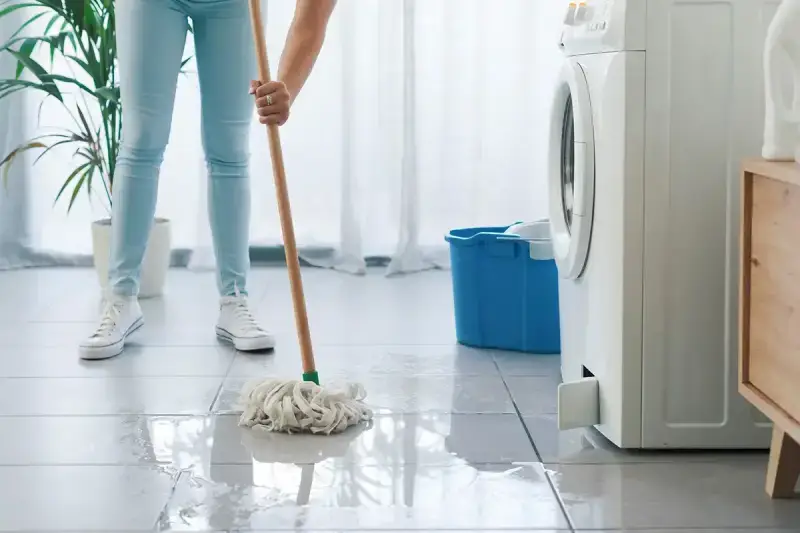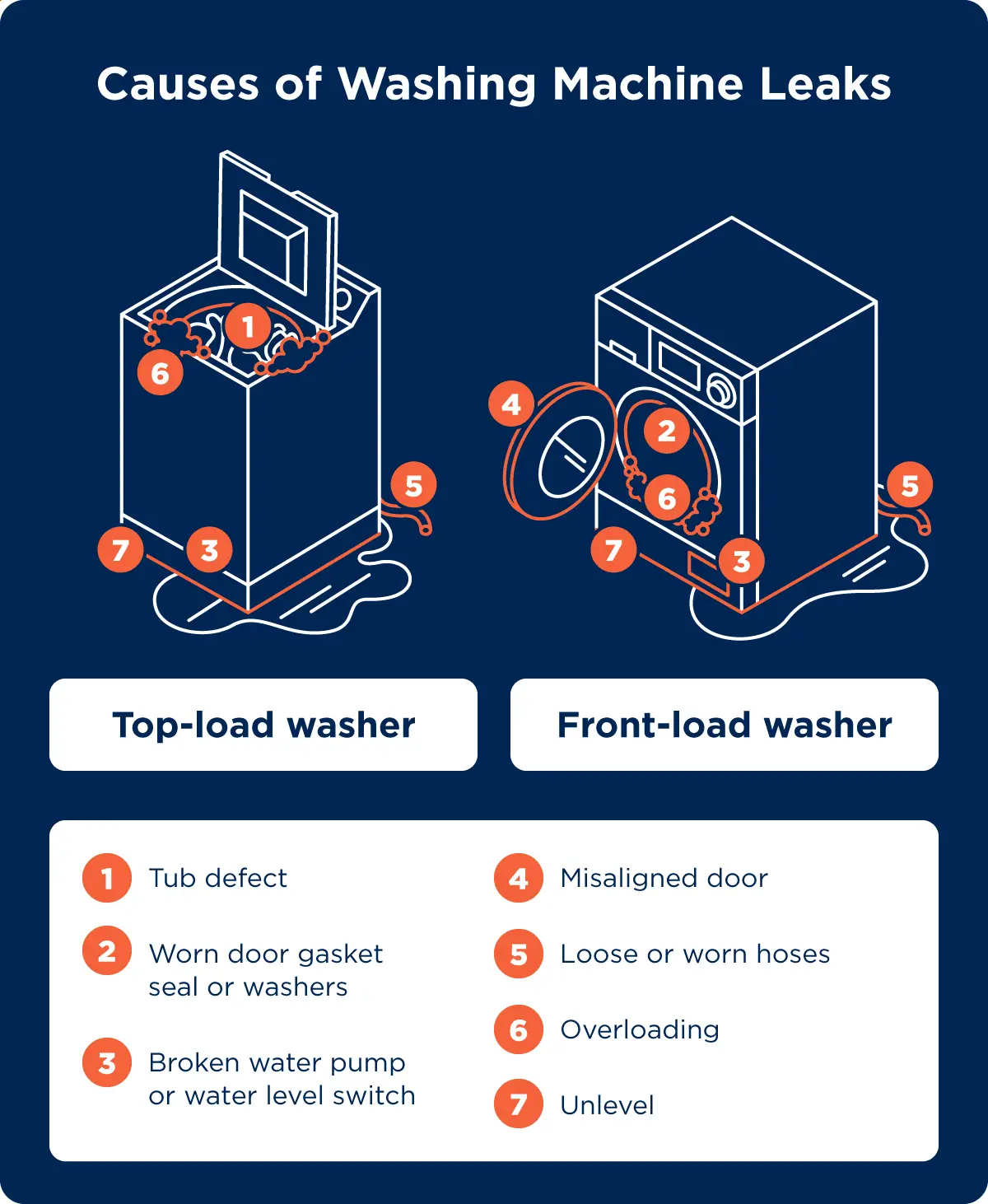How To Fix a Leaking Washing Machine

|
A leaking washing machine can be caused by any number of things, like overloading the washer, damage to the fill hose, and using the wrong or too much detergent. |
Are you concerned about the puddle of water you just found on the laundry room floor? Don’t panic.
While a washer leaking from the bottom can cause a headache, learning how to spot the first signs can help prevent further water damage and mitigate the problem as quickly as possible.
Discover how to identify washing machine leaking water problems with a breakdown of common causes, how to fix them, and how to tell when it's time to call a Mr. Appliance® service professional.
Signs Your Washing Machine Is Leaking
In some instances, what appears to be a washing machine leaking may just be a spill. It’s important to figure out if the washer is actually leaking and then determine where the water is coming from before you start trying to repair it.
Some common signs of a washing machine leak include:
- Water pooling near the bottom of the washer
- Soggy floor near the washer
- Musty smell
- Signs of water damage
To further test if the washer is leaking:
- Make sure the water you find isn’t just from a spill or clogged drain.
- Test if the washer is leaking by wiping up the water, drying the area, and running a normal wash cycle.
- Check under and behind the appliance for water.
- If another puddle has formed, it’s time to answer the question, “Why is my washer leaking?”
12 Causes of a Leaking Washing Machine
Before you initiate any repairs, make sure your washer is unplugged and the water to the washer is turned off to avoid any accidents or further messes. Now you’re ready to troubleshoot the most common culprits of a leaky washing machine.
1. Clogged Overflow Tube
This is one of the most common causes of a leaking washing machine. It's typically due to a buildup of detergent remnants, like if you use too much or the wrong type of product.
How To Fix It
To see if you’re using too much detergent, place a freshly washed item in a bowl of water. If the water becomes soapy, reduce the amount of detergent you use. High-efficiency (HE) washing machines use special HE detergents, which require less detergent per wash.
2. Overloaded Washer
Washing machines that are too full can leak. Never fill your washing machine above the recommended line.
How To Fix It
Consider doing laundry more frequently or in smaller batches to avoid overfilling. This small washing machine maintenance change can make a big difference.
3. Unlevel Washer
An unlevel washing machine will be off balance, causing a strain on the internal components. This can lead to misalignment, which causes water to escape from seals and connections, resulting in a leak from the bottom front of the machine.
How To Fix It
To level a washing machine, simply adjust the feet. To do so safely, ensure your machine is unplugged and that you use at least two people (or hire a professional) to safely lift it so you can adjust the feet at the base of the washer. Your owners manual has complete instructions.
4. Disconnected Drain Pipe
Accidental disconnection, wear and tear, or improper installation can cause a disconnected or loose drain hose. If the drain hose isn’t properly secured to the drain pipe, it can cause a leak at the back of the washer.
How To Fix It
Check the connection at the back of the machine. If it appears loose, all you need to do is ensure the drain hose is properly inserted into the drain pipe. See your owner's manual for the proper installation.
5. Clogged Drain Pipe
If the connection between the drain hose and pipe appears fine, but there’s still a leak at the back of the washer, it’s likely due to a clog. Clogs are often caused by lint buildup.
How To Fix It
There are several ways to fix a clogged drain pipe, all of which are similar to how you might fix a clogged sink. You can use a drain cleaner or try to snake the drain pipe. A serious clog may require the help of a service professional, who can use a power auger or other tools to unclog the drain.
6. Disconnected Fill Hose
Leaks from the back of the washer can also be caused by a disconnected or broken fill hose. Over time, these rubber hoses crack, become brittle, and leak, requiring replacement.
How To Fix It
Start by inspecting the fill hose for any cracks, tears, or holes. If you find any damage, replace the hose. If you don’t feel confident replacing it yourself, hire a professional for help. If there isn’t any visible damage, ensure the hose is securely connected to the water supply valve and the washer. Tighten any clamps or fittings.

7. Worn Rubber Washers
Rubber washers, located on either end of your fill hoses, can deteriorate over time due to age and general wear and tear. When worn or damaged, they can no longer effectively seal water, leading to leaks.
How To Fix It
Replacing worn washers requires you to turn the water off, remove the washer hoses and pull out the old washers and put in the new ones. Then replace the hoses and turn the water back on. Make sure you check for leaks after replacing the washers. . A service professional can accurately identify the damaged washers and replace them with new ones if you are not comfortable doing this yourself.
8. Water Pump Leak
The water pump removes the dirty water in the machine. When it malfunctions, it may cause water to leak out through the bottom of your washing machine.
How To Fix It
Replace the water pump immediately if you see it leaking. If you're handy, you may be able to replace the water pump yourself. If not, a Mr. Appliance service professional is just a phone call away.
9. Tub Defect
The tub of the washing machine consists of two parts: the part you see with drain holes in it and an outer tub. If there’s a defect or crack in the outer tub, it will cause a leak.
How To Fix It
Replacing a damaged tub requires specific tools and knowledge, so it’s best to call a professional.
10. Malfunctioning Water Level Switch
The water level switch or sensor ensures the machine fills with water to the correct level. If it stops working properly, the washing machine will overfill.
How To Fix It
Replacing this part requires the right tools and expertise, so call your local Mr. Appliance for repair service.
11. Broken Door Gasket Seal
Specific to front-load washing machines, the door gasket seal is a rubber component that provides a watertight seal between the washer’s door and the tub. Over time, deterioration or detergent buildup can wear down the gasket and cause a leak.
How To Fix It
Clean the gasket regularly to avoid product buildup and mold. You can also try switching detergents and using less to avoid product buildup. Additionally, opt for dryer sheets or wool dryer balls rather than liquid fabric softener. If this doesn’t help, call your local Mr. Appliance to have them replace the door gasket for you.
12. Misaligned Door
Also specific to front-load machines, the door itself can be the cause of a washing machine leak. If the door is misaligned or not latching properly, it can cause water to leak out.
How To Fix It
Loosening the hinges and retightening them will usually resolve the problem. If not, contact your local Mr Appliance.
Trust Mr. Appliance for Washing Machine Repair
Knowing why your washer is leaking from the bottom doesn’t necessarily mean you’ll be able to — or want to — repair it yourself. Your local Mr. Appliance professionals have the expertise and experience to identify the problem and resolve it as quickly as possible.
Our team of service professionals is committed to delivering exceptional results so you can resume your household routine and minimize the inconvenience associated with a broken appliance.
Schedule appliance repair services today!
This article is intended for general informational purposes only and may not be applicable to every situation. You are responsible for determining the proper course of action for your home and property. Mr. Appliance is not responsible for any damages that occur as a result of this blog content or your actions. For the most accurate guidance, contact the Mr. Appliance location nearest you for a comprehensive, on-site assessment.
FAQ About a Washing Machine Leaking Water
Decades of experience, highly skilled service professionals, and a commitment to exceptional customer service have made Mr. Appliance a trusted leader in appliance maintenance and repairs. Our commitment to keeping your appliances up and running includes using our many years of experience and expertise to answer your appliance-related questions.
Here are answers to some of the most frequently asked questions about a washer leaking from the bottom.
Can Overloading a Washer Cause It To Leak From the Bottom?
Yes, an overloaded washing machine can leak. This is a common cause of a washing machine leaking, and it's why you should avoid overfilling the machine.
Is It Worth Fixing a Leaking Washing Machine?
Yes, it is worth fixing a leaking washing machine. Most washing machines can be fixed by making some simple adjustments or repairs or by having the machine assessed by a service professional.
Why Has My Washing Machine Flooded My Floor?
There are many reasons why a washing machine may have flooded the floor. Determining where the water is coming from is the first step in narrowing down potential causes, including using too much detergent, a clog in the tubing, an unbalanced machine, or an improperly sealed gasket.
How Do You Fix a Leaking Washing Machine?
First, identify the source of the leak. For example, is it coming from the hoses, the drum, or the door? Next, address the issue. This might involve tightening a loose hose, replacing a worn gasket, or calling a professional for more complex repairs.
 Click to call
Click to call



